Rod Puppet Item Number: Ib389 a-c from the MOA: University of British Columbia


Description
Three-dimensional male humanoid figure (part a); large head (part b) and jointed arms attached to controlling rods. There is a single controling rod that is pointed (part c). Cream coloured face positioned downwards with straight pointed nose, closed red lips. Hair, eyebrows, facial features, and eyes outlined in black. Red crown (mahkota) headdress with four-tiered diadem in gold, green, white, and black. Decorated with karawista, sumping, small Garuda Mungkur with siyung jawi and dawala in same colours. Long black hair falls in seven curls with gold highlights. Gold neck and torso; arms have green, white and red ornaments at wrists and biceps. Hands are held flat and bent back at wrist. Black chest covering and apron with white wavy trim, sequins, beads, and wound wire in cross shaped patterns. Apron has black waistband, long yellow fringe at bottom. Batik skirt: beige with brown and lavender. Hand controlling rods are painted black.
History Of Use
Javanese puppetry as an art form probably developed by the 11th century. Wayang golek puppets of western Java appeared during the 16th century. Originally the plays depicted Javanese mythology, but after the Indian conquest of Java the Hindu epics, Ramayana and Mahabharata, were incorporated into the cycles, which comprise about 200 plays. A dalang (puppet master) performs the plays to celebrate important occasions, usually in three acts, with vocal and instrumental accompaniment. Typically they serve a moral and religious purpose, and more recently, one of political commentary. Puppet possibly represents a manifestation of Rama in other than standard form. Puppets commonly have several variants, which often have different names; the variants suggests differences in age, maturity, or mood.
Iconographic Meaning
Each puppet is characterized by its wanda, a Javanese word which describes the specific mixture of elements of size, form, colour, ornamentation and carving. Colour, position, delicate features of face suggest nobility, virtue, and often youth. Crown headdress reserved for the highest nobility, also found on gods. Position of hands, batik skirt, and arm ornament also indicate nobility. Headdress and face very similar to standard form of Rama, although variations are found: there is more hair, and less badong.
Cultural Context
Theatrical performance.
Item History
- Made in Java, Indonesia
- Owned by Donald Bone before January 4, 1980
- Received from Donald Bone (Seller) and Museum of Anthropology Donations Fund (Funding source) on January 4, 1980
What
- Name
- Rod Puppet
- Identification Number
- Ib389 a-c
- Type of Item
- puppet
- Material
- cotton fibre, paint, fibre and wood
- Manufacturing Technique
- carved, sewn, woven, painted and tied
- Part A
- height 64.0 cm, width 18.0 cm, depth 7.0 cm
- Part B
- height 21.0 cm, width 8.0 cm, depth 18.0 cm
- Part C
- height 29.0 cm, width 2.0 cm, depth 2.2 cm
Who
- Culture
- Sundanese
- Previous Owner
- Donald Bone
- Received from
- Donald Bone (Seller) and Museum of Anthropology Donations Fund (Funding source)
Where
- Holding Institution
- MOA: University of British Columbia
- Made in
- Java, Indonesia
When
- Ownership Date
- before January 4, 1980
- Acquisition Date
- on January 4, 1980
Other
- Condition
- good
- Accession Number
- 0586/0008 a-c